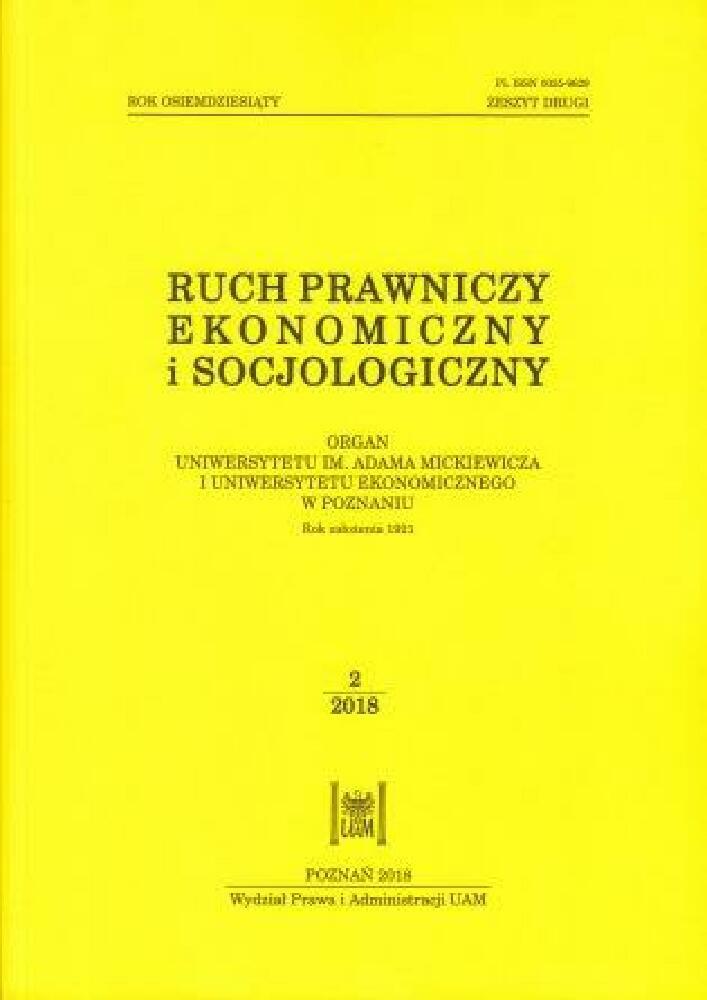Abstrakt
Jednym z filarów programu badawczego heterodoksyjnego postkeynesizmu jest endogeniczna kreacja podaży pieniądza. Zgodnie z nią ilość pieniądza w obiegu samoistnie dostosowuje się do potrzeb zgłaszanych przez podmioty gospodarcze. Zapewnienie odpowiedniej podaży środków finansowych jest rolą banków komercyjnych, które kreują pieniądz kredytowy ex nihilo. Natomiast zadaniem władz monetarnych jest dostarczanie bankom komercyjnym rezerw pieniężnych gwarantujących ciągłość akcji kredytowej, a tym samym procesu produkcji i wymiany w gospodarce. Podczas gdy postkeynesiści zgadzają się co do endogenicznego charakteru podaży pieniądza, to nie wszyscy w ten sam sposób postrzegają rolę i działania banku centralnego w kierunku zaspokajania popytu na rezerwy zgłaszanego przez banki komercyjne. W rezultacie ukształtowały się cztery postkeynesowskie interpretacje tej kwestii: akomodacyjne, strukturalistyczne, z perspektywy teorii obiegu pieniężnego oraz z perspektywy preferencji płynności. Celem artykułu jest przybliżenie tych ujęć oraz wskazanie, w czym są one odmienne od stanowiska głównego nurtu ekonomii oraz w jakim stopniu różnią się między sobą. Podkreślono również wpływ takiej heterogeniczności poglądów na spójność postkeynesizmu i możliwość stworzenia przez tę szkołę alternatywy dla neoklasycznej ortodoksji.
Bibliografia
Ahmad, N., Ahmed, F. (2006), The Long-Run and Short-Run Endogeneity of Money Supply in Pakistan: An Empirical Investigation, State Bank of Pakistan – Research Bulletin 2(1): 267–278.
Almutair, S. (2015), The Endogenous Money Hypothesis: an Empirical Study of The Saudi Arabia, International Journal of Social Science and Economics Invention 01(03): 1–18.
Badarudin, Z.E., Ariff, M., Khalid, A.M. (2013), Post-Keynesian Money Endogeneity Evidence in G-7 Economies, Journal of International Money and Finance 33: 146–162.
Caporale, G.M., Howells, P.G.A. (2001), Money, Credit and Spending: Drawing Causal Inferences, Scottish Journal of Political Economy 48(5): 547–557.
Cepni, O., Guney, I.E. (2017), Endogeneity of Money Supply, Journal of Finance and Banking Studies 6(1): 1–10.
Cifter, A., Ozun, A. (2007), The Monetary Transmission Mechanism in the New Economy: Evidence from Turkey (1997–2006), South East European Journal of Economics and Business 2(1): 15–24.
Elhendawy, E.O. (2016), Money Supply – Exogenous or Endogenous? An Empirical Evidence from Egypt, International Journal of Economics, Commerce and Management 4(2): 42–58.
Fontana, G. (2003), Post Keynesian Approaches to Endogenous Money: A Time Framework Explanation, Review of Political Economy 15(3): 291–314.
Fontana, G. (2004), Rethinking Endogenous Money: A Constructive Interpretation of the Debate Between Horizontalists and Structuralists, Metroeconomica 55(4): 367–385.
Gedeon, S. (1985), The Post Keynesian Theory of Money: A Summary and an Eastern European Example, Journal of Post Keynesian Economics 8(2): 208–221.
Goodhart, C. (1989), Has Moore Become too Horizontal?, Journal of Post Keynesian Economics 12(1): 29–34.
Haghighat, J. (2011), Endogenous and Exogenous Money: An Empirical Investigation from Iran, Journal of Accounting, Finance and Economics 1(1): 61–76.
Howells, P.G.A. (1995), The Demand for Endogenous Money, Journal of Post Keynesian Economics 18(1): 89–106.
Howells, P.G.A. (1997), The Demand for Endogenous Money: A Rejoinder, Journal of Post Keynesian Economics 19(3): 429–435.
Howells, P., Hussein, K. (1998), The Endogeneity of Money: Evidence from the G7, Scottish Journal of Political Economy 45(3): 329–340.
Kaldor, N. (1982), The Scourge of Monetarism, New York.
Keen, S. (2011), Debunking Macroeconomics, Economic Analysis and Policy 41(3): 147–167.
Lavoie, M. (1992), Foundations of Post-Keynesian Economic Analysis, Aldershot.
Moore, B.J. (1978), A Post Keynesian Approach to Monetary Theory, Challenge 21(4): 44–52.
Moore, B.J. (1979), The Endogenous Money Stock, Journal of Post Keynesian Economics 2(1): 49–70.
Moore, B.J. (1983), Unpacking the Post Keynesian Black Box: Bank Lending and Money Supply, Journal of Post Keynesian Economics 5(4): 537–556.
Moore, B.J. (1985a), Wages, Bank Lending, and the Endogeneity of Credit Money, [w:] Money and Macro Policy, red. M. Jarsulic, Boston: 1–28.
Moore, B.J. (1985b), Contemporaneous Reserve Accounting: Can Reserves Be Quantity Constrained?, Journal of Post Keynesian Economics 7(1): 103–113.
Moore, B.J. (1986), How Credit Drives the Money Supply: The Significance of Institutional Developments, Journal of Economics Issues 20(2): 443–452.
Moore, B.J. (1988), Horizontalists and Verticalists. The Macroeconomics of Credit Money, Cambridge.
Moore, B.J. (1988), The Endogenous Money Supply, Journal of Post Keynesian Economics 10(3): 372–385.
Nayan, S., Ahmad, M., Kadir, N., Abdullah, M.S. (2013), Post Keynesian Endogeneity of Money Supply: Panel Evidence, MPRA Paper 48716: 1–6.
Nell, K.S. (2000–2001), The Endogenous/Exogenous Nature of South Africa’s Money Supply under Direct and Indirect Monetary Control Measures, Journal of Post Keynesian Economics 23(2): 313–329.
Palley, T.I. (1994), Competing Views of the Money Supply Process: Theory and Evidence, Metroeconomica 45(1): 67–88.
Palley, T.I. (1996), Accommodationism versus Structuralism: Time for an Accommodation, Journal of Post Keynesian Economics 18(4): 585–594.
Panagopoulos, Y., Spiliotis, A. (2008), Alternative Money Theories: A G7 Testing, Journal of Post Keynesian Economics 30(4): 601–622.
Piégay, P. (2003), Post Keynesian Controversies on Endogenous Money: An Alternative Interpretation, [w:] Rochon L.-P., Rossi, S. (eds.) Modern Theories of Money. The Nature and Role of Money in Capitalist Economies, Cheltenham: 246–262.
Pollin, R. (1991), Two Theories of Money Supply Endogeneity: Some Empirical Evidence, Journal of Post Keynesian Economics 13(3): 366–396.
Rath, D.P. (1999), Does Money Supply Process in India Follow a Mixed Portfolio: Loan Demand Model?, Economic and Political Weekly 34(3–4): 139–144.
Rochon, L.-P. (1999), Credit, Money and Production. An Alternative Post-Keynesian Approach, Cheltenham.
Seccareccia, M. (2003), Pricing, Investment and the Financing of Production within the Framewor of the Monetary Circuit: Some Empirical Evidence, [w:] Rochon L.-P., Rossi, S. (eds.), Modern Theories of Money: the Nature and Role of Money in Capitalist Economies, Cheltenham: 173–197.
Setterfield, M. (2014), An Essay on Horizontalism, Structuralism and Historical Time, Trinity College Department of Economics Working Paper 14-02: 1–13.
Shanmugam, B., Nair, M., Li, O.W. (2003), The Endogenous Money Hypothesis: Empirical Evidence from Malaysia (1985–2000), Journal of Post Keynesian Economics 25(4): 599–611.
Vera, A.P. (2001), The Endogenous Money Hypothesis: Some Evidence from Spain 1987–1998, Journal of Post Keynesian Economics 23(3): 509–526.
Vymyatnina, Y. (2006), How Much Control Does Bank of Russia Have Over Money Supply?, Research in International Business and Finance 20(2): 131–144.
Wray, L.R. (1990), Money and Credit in Capitalist Economies. The Endogenous Money Approach, Aldershot.
Licencja
Prawa autorskie (c) 2018 WPiA UAM

Utwór dostępny jest na licencji Creative Commons Uznanie autorstwa – Użycie niekomercyjne – Bez utworów zależnych 4.0 Międzynarodowe.




